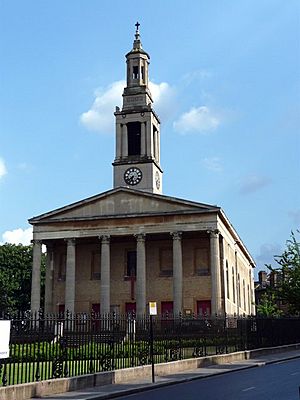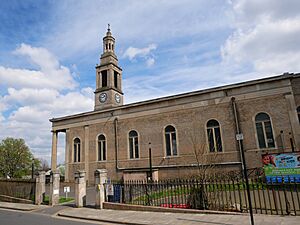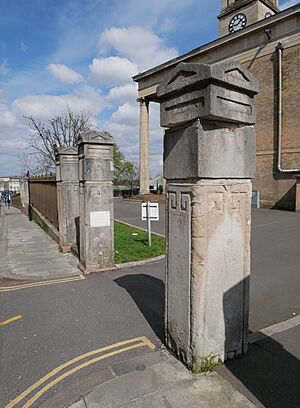St Luke's Church, West Norwood facts for kids
Quick facts for kids St Luke's, West Norwood |
|
|---|---|
 |
|
| Denomination | Church of England |
| Churchmanship | Evangelical |
| Architecture | |
| Architect(s) | Francis Octavius Bedford |
| Administration | |
| Deanery | Lambeth South |
| Archdeaconry | Lambeth |
| Diocese | Diocese of Southwark |
| Province | Canterbury |
St Luke's Church is a historic Church of England church in West Norwood, London. It is a special building, officially recognized as Grade II* listed building, which means it is a very important part of England's history. The church sits on a large piece of land where Norwood Road splits into two other streets, Knights Hill and Norwood High Street.
Contents
History of the Parish
When St Luke's was built, West Norwood was a very different place. It was mostly fields and woods, with only a few houses. Over time, the area grew and became a busy part of London.
As more people moved to the area in the 1800s, other new churches were built nearby. This meant the original parish (the area served by St Luke's) was divided up.
The number of people living in the parish has changed a lot.
- In 1886, about 10,377 people lived in the parish.
- By 1901, the population had grown to 16,180.
- More recently, the population was estimated to be 15,400 in 2001 and 16,500 in 2011.
The Church Building
Why Was St Luke's Built?
St Luke's Church was designed in 1822 by an architect named Francis Octavius Bedford. It was built after the Napoleonic wars ended. The government wanted to build new churches for the growing number of people moving into cities. This was part of a project called the Church Building Act 1818.
Churches like St Luke's are often called "Commissioners' churches" because they got money from a group called the Church Building Commission. St Luke's cost £12,947 to build, and the commission gave £6,447 of that money.
It was one of four churches built in south London at the same time, known as the "Waterloo churches". Each one was named after one of the four gospel writers in the New Testament: Matthew, Mark, Luke, and John.
A Surprising Design
Most Christian churches are built facing east towards the rising sun. But St Luke's faces south. This was because of a rule that said no new building could be built within 100 feet of another building without permission.
The owner of a nearby pub, the Horn's Tavern, objected to the church being too close. To follow the rule, the architect had to turn the whole building sideways.
The church was built by a company run by Mrs Elizabeth Broomfield. The first stone was laid on April 14, 1823, and the church officially opened on July 25, 1825. The front of the church has a grand entrance with six tall, fluted columns, in a style inspired by ancient Greek buildings. A tower rises from the roof just behind the entrance.
Changes Inside the Church
The inside of the church has changed a lot over the years. At first, it had box pews (seats enclosed by wooden walls) and a tall, three-level pulpit. It also had galleries, or upper floors, to fit more people.
The original plan was to have just one gallery at the back. But to fit even more people, a second gallery was added at the front. This meant the altar (the holy table) had to be moved to one of the long side walls, which was very unusual. A writer in 1827 said the church looked like it had been "turned on one side" and that the layout was "awkward".
In the 1870s, an architect named George Edmund Street made big changes. He removed the galleries and rearranged the inside to a more traditional layout. He added large arches and a curved ceiling, which made the church look completely different. These changes also meant fewer people could sit inside.
More recently, in 1976, the front part of the church, called the chancel, was divided to create halls and a kitchen. In 2005, the old wooden pews were replaced with modern red chairs.
The Churchyard
Between 1825 and 1894, about 1,383 people were buried in the churchyard or in vaults underneath the church. No more burials can take place there now.
After World War II, the lower part of the churchyard was turned into a memorial garden to remember people who died in the war. The local council looks after this garden.
The original iron railings around the churchyard were taken away during the war to be used for scrap metal. New railings, copied from the old design, were finally put back in 2009. The upper part of the churchyard is still owned by the church but is also looked after by the council.
The Famous Church Clock
The clock at St Luke's is very important in the history of clock-making. It was made by Benjamin Lewis Vulliamy in 1827.
Vulliamy had created a new way to build large clocks, called a ‘flat-bed’ design. The clock at St Luke's was the very first of its kind in England. It has a long pendulum that swings every two seconds.
In 1928, the clock's faces were replaced with a special glass that could be lit up from behind at night. The clock stopped working for many years, but it was fully repaired and restored in 2017.
See also



